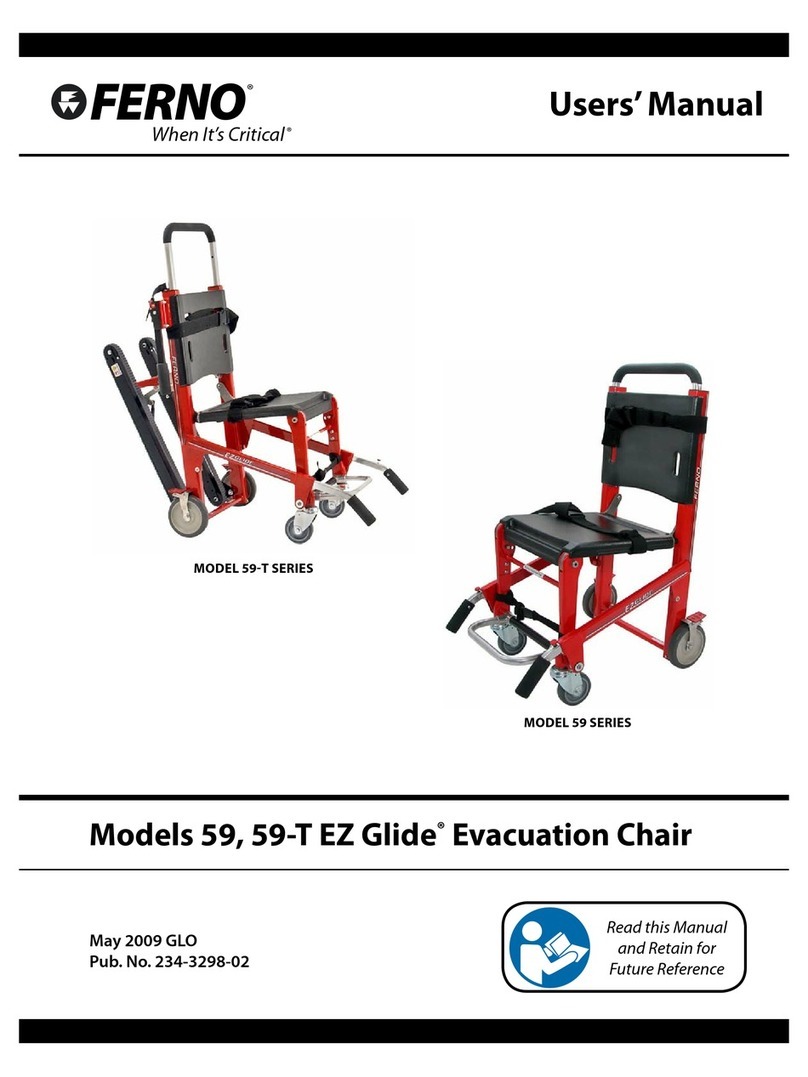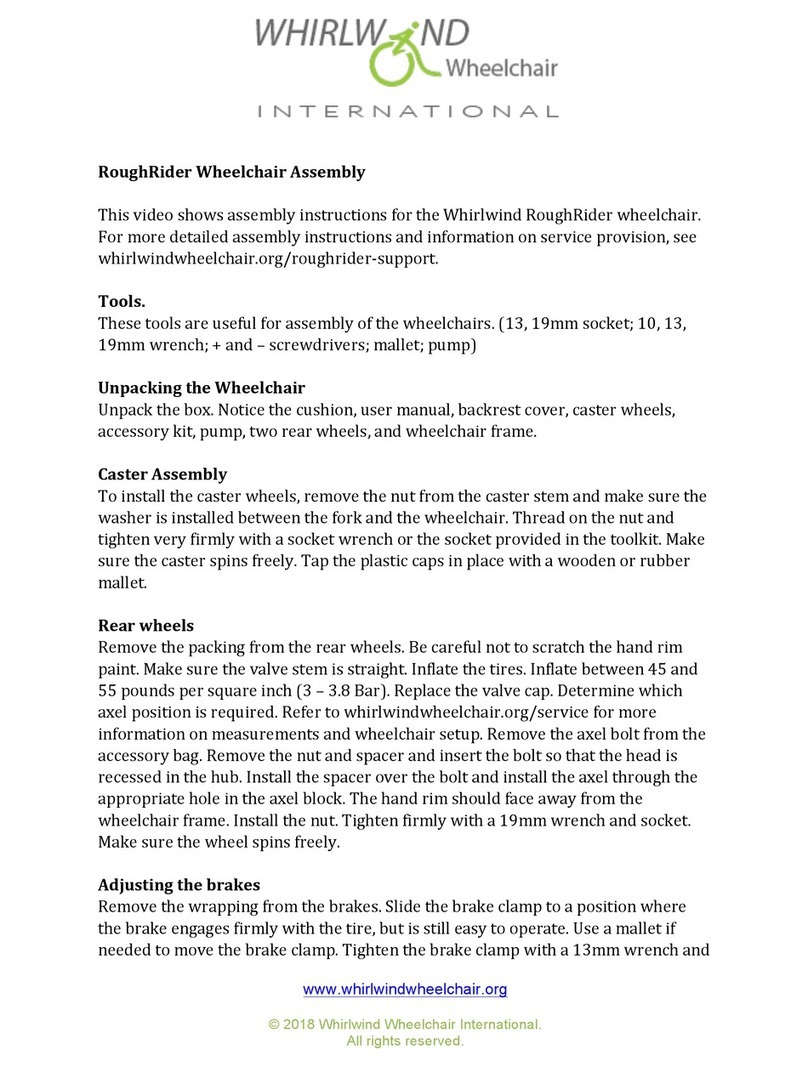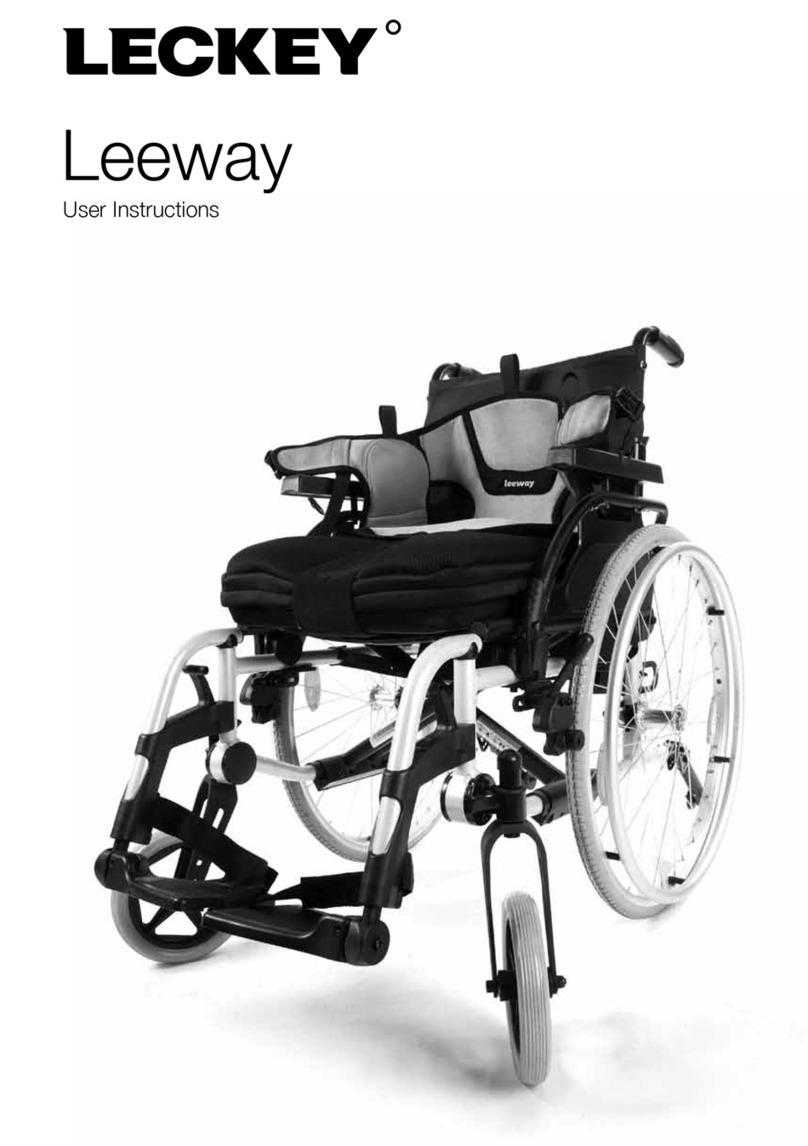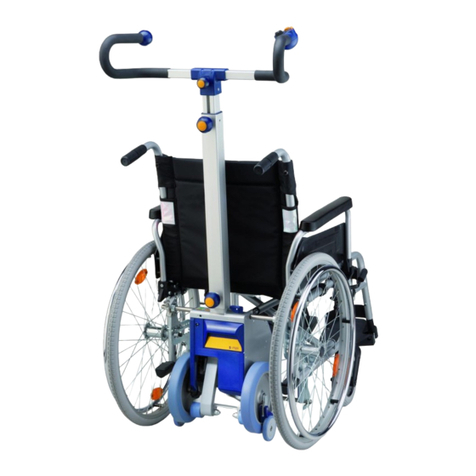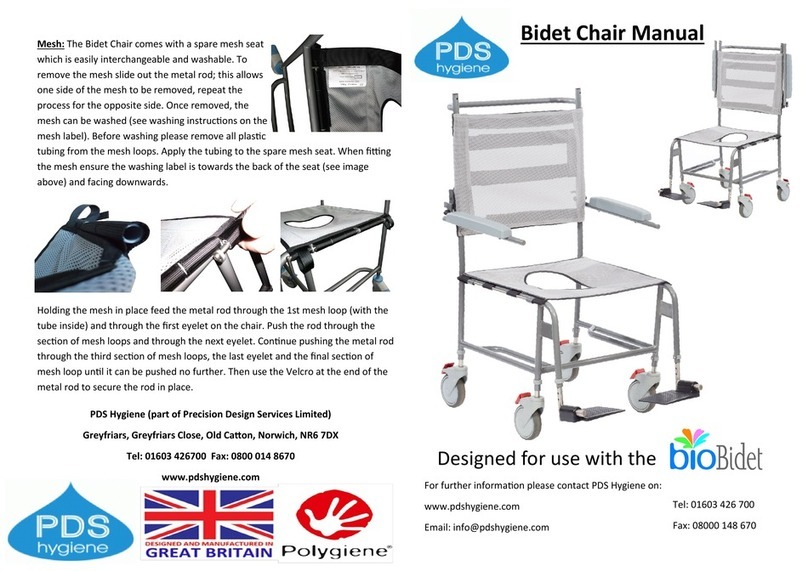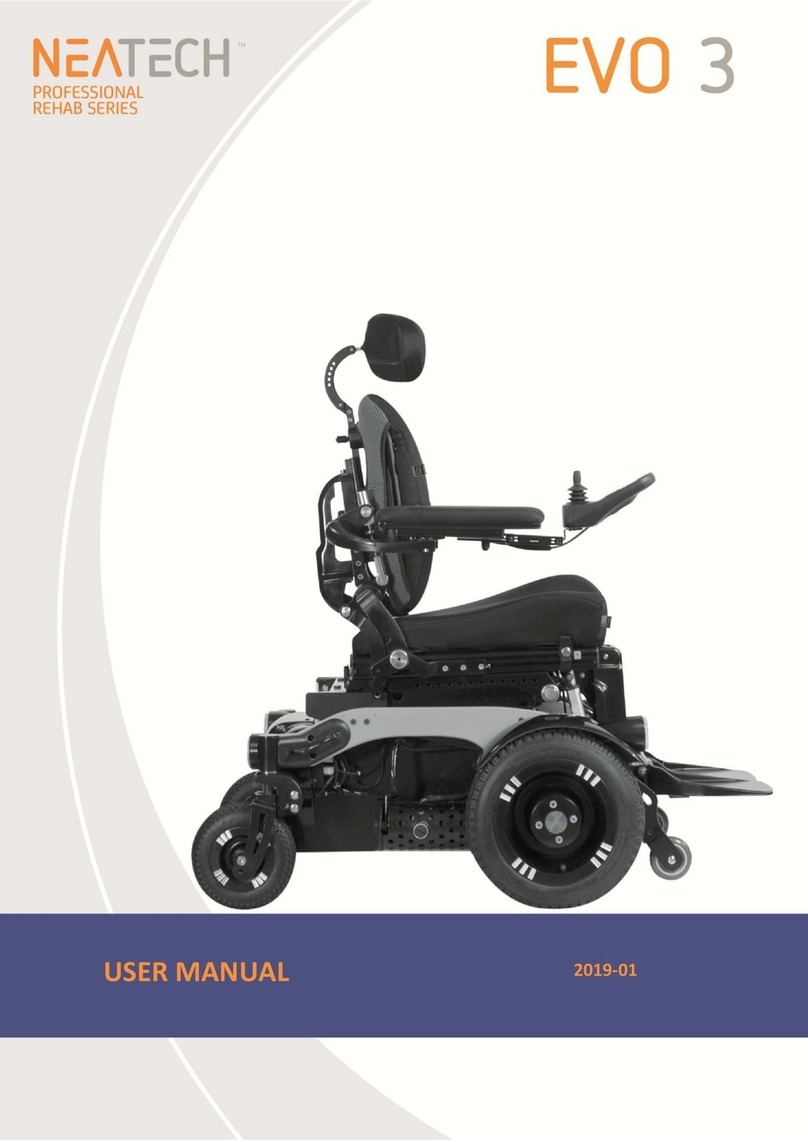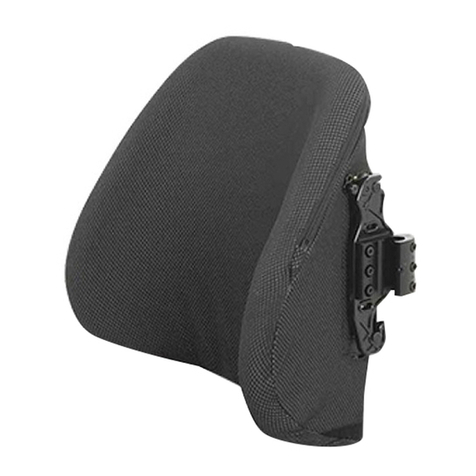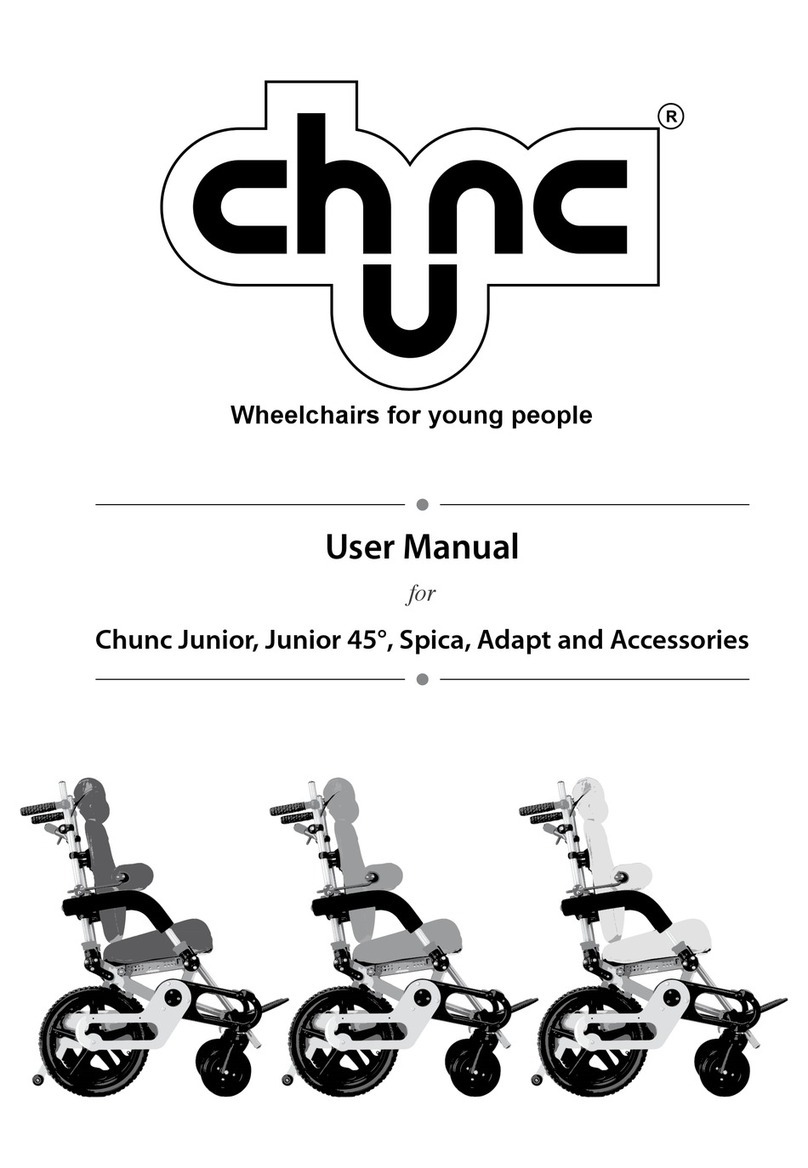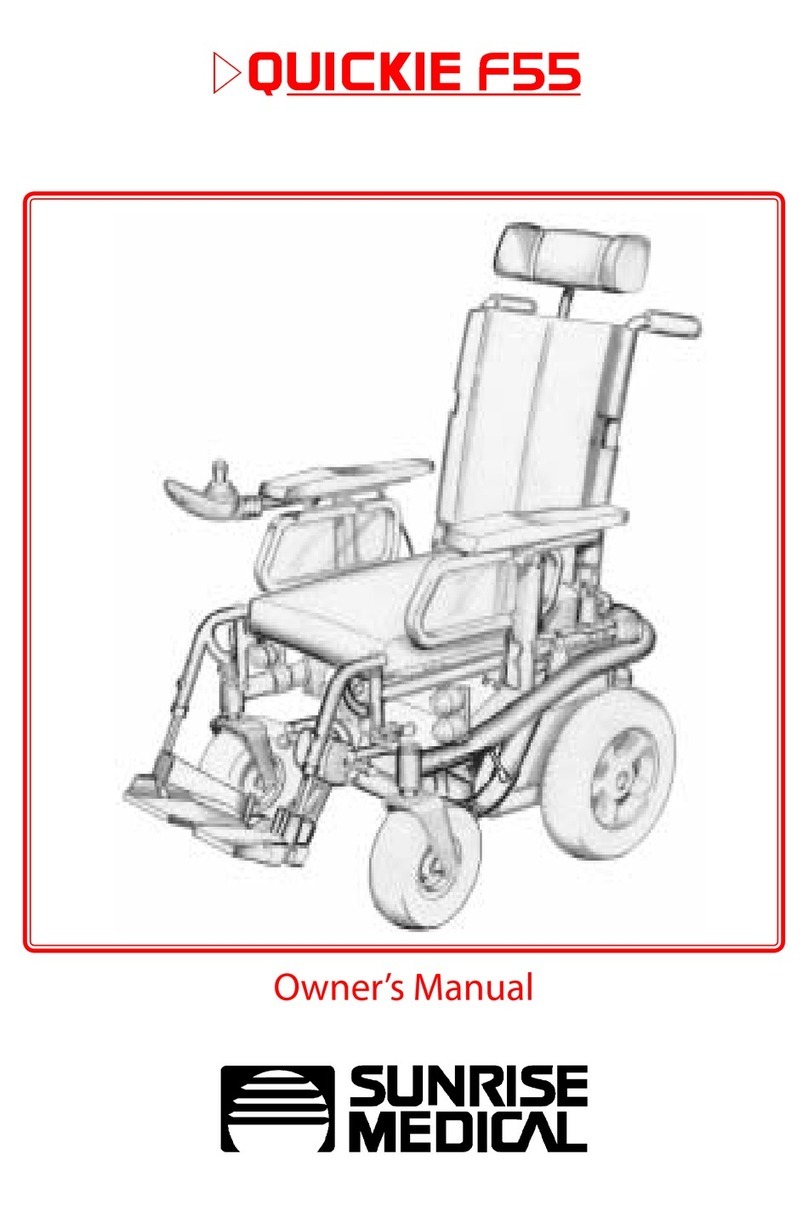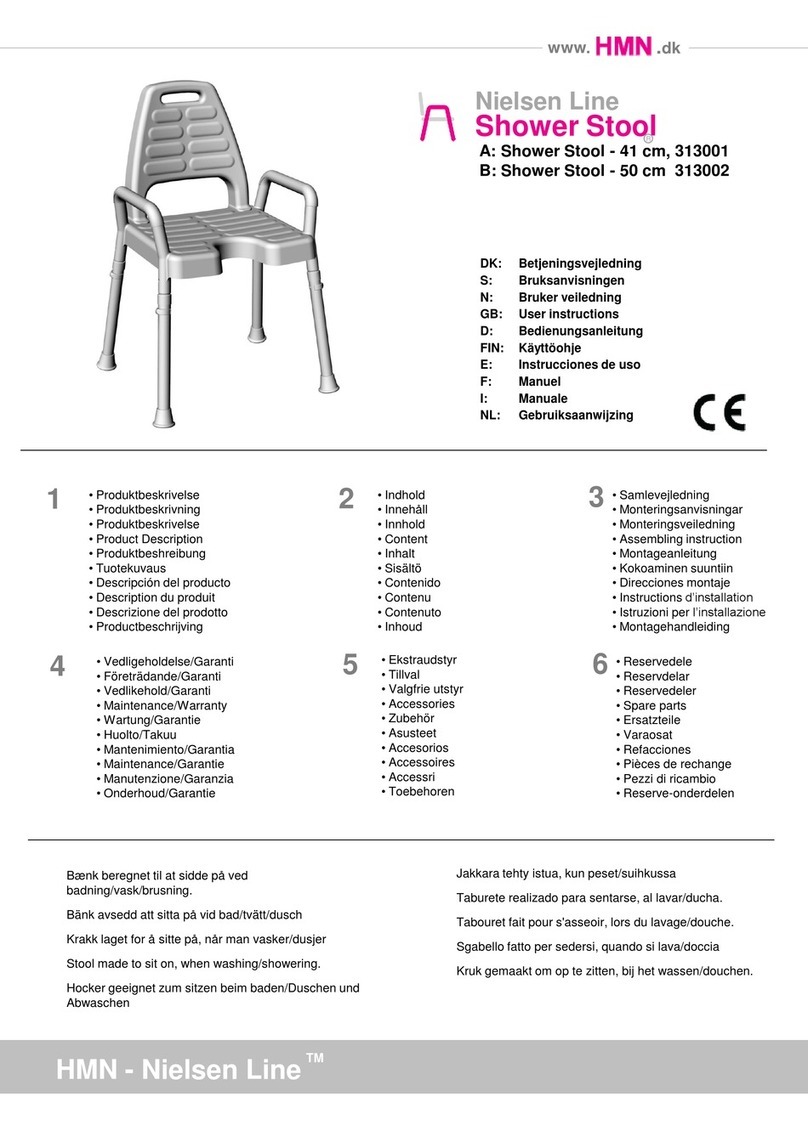HENRY Attendant Propelled User manual

Nov 1998 Rev 2
Section 2 Index
MANUAL WHEELCHAIRS
GENERAL GUIDE AND SAFETY INFORMATION
THIS INFORMATION IS APPLICABLE TO ALL MANUAL WHEELCHAIRS
IT SHOULD BE READ BY BOTH OCCUPANTS AND CARERS WITH ALL OTHER
INFORMATION SUPPLIED BEFORE ANYONE ATTEMPTS TO USE THE CHAIR
THE PURPOSE OF A WHEELCHAIR IS TO PROVIDE FUNCTIONAL MOBILITY FOR
PEOPLE WHO CANNOT, OR FIND IT DIFFICULT TO WALK.
Factors considered in selecting a wheelchair apply to both occupants and carers
and include:
• method of propulsion
• seating position
• occupant size and weight
• physical ability of occupant and carer ( where applicable )
• ease of use
• environment
• safety
• degree of independence
• transportation
• costs
Clinical Assessment teams have a responsibility to provide the wheelchair
occupant and carer, where applicable, with a means of acheiving effective
mobility, bearing in mind all the above considerations.
There are many different types and variations of wheelchairs available today. It
may not be possible to satisfy all requirements and environments with one chair
for every need of the occupant (and carer) for home, travel or work.
HenryCare Wheel Chair Instructions
Source-remobility.net

Nov 1998 Rev 2
Section 2 Index
2.1 INTRODUCTION
The type of wheelchair, and attachment features, provided will be different
according to individual user requirements, and clinical assessment of need.
In many cases the result will be a compromise solution.
Some modular wheelchairs can be set up or finely adjusted to suit user needs.
Users should contact their approved distributor if they are having problem in using
their wheelchair, a simple adjustment or alternative build configuration may help to
resolve the problem.
Remploy manual wheelchairs can be divided into three broad categories.
•Attendant Propelled
•Occupant Propelled
•Pushchairs and Buggies
This general information section covers safety issues of wheelchair use covering
all of these.
Please read carefully together with all other information provided, covering the
specific model supplied, which will give particular details of the wheelchair
features and construction, methods of operation and correct setting methods.
HenryCare Wheel Chair Instructions
Source-remobility.net

Nov 1998 Rev 2
2.1.2 GETTING IN AND OUT OF A WHEELCHAIR FACING FORWARDS
Section 2 Index
For maximum safety, these operations should be carried out with the help of an
attendant. The occupant should always try to assist the attendant wherever
possible to share the total effort. Carers should not attempt to lift without help.
If this is not possible a hoist may be required.
Getting into the wheelchair.
Make sure that the brakes are on, flip up the foot plates, taking care that the heel
support straps (if fitted) are not jammed against the footrest support frame. On
some models, footrests may be detached or swung away for easier access. Note
that when footrests are detached, the mounting swivels remain exposed, and care
should be taken to avoid the occupant catching these accidentally.
The occupant may be able to help by pushing on the armrests to provide support
whilst being lowered into the seat. Finally, push the footplates down, and locate
the occupant`s feet on them. see fig 1.
Getting out of the wheelchair.
Make sure that the brakes are on,then flip up the footrests or detach them as in
section 2.1. The occupant should place a hand on each armrest, bend slightly
forward and place both feet well back and firmly on the ground, then push
upwards to assist the carer.
2.1.3 SIDE TRANSFER
When the wheelchair armrest is removed, it will allow sideways entry to the chair
and vice versa, from another chair or car seat. see fig 2. Physically active
Independent users with upper body and arm strength should eventually develop
skill to carry out this manoeuvre without help. However, it is advisable that an
attendant should be available if assistance becomes necessary.
Make sure the brakes are on, or that the wheelchair is prevented from moving, It
is easier to transfer when flip up footrest assemblies are swung back out of the
way, or removed so as not to interfere with the legs. Fixed frame wheelchairs with
foot bars, which do not have protruding brackets and footplates, allow side
transfer without the need for footrest removal. Feet should be firmly on the ground
and not on the footrest. The safest way to transfer is to bend slightly forward.
DO NOT ATTEMPT SIDE TRANSFER ON SLIPPERY OR UNEVEN FLOORS
If there is a gap between the two seat surfaces, it may help to slide along a
smooth transfer board, or to use some other lever point such as a car hand grip
for additional support whilst manoeuvring from one seat to the other.
HenryCare Wheel Chair Instructions
Source-remobility.net

Nov 1998 Rev 2
Section 2 Index
Figure 1 - Getting in/out of the wheelchair
Figure 2 - Side Transfer
Figure 3 - Maintain a firm grip on the push handles
Figure 4 - Attendant Control
HenryCare Wheel Chair Instructions
Source-remobility.net

Nov 1998 Rev 2
2.1.4BRAKES Section 2 Index
Hand brakes are provided for preventing wheel movement when parked,
particularly on a slope, or during occupant transfer to and from the wheelchair.
The action of a brake shoe pressing on the tyre makes correct inflation pressure
important, see section 12.1.
Cable operated hub brakes are an option available for mounting on the push
handles to allow the attendant to control the chair without having to reach down
for the hand brake handle. These may also provide the attendant with a means of
controlling the speed of a wheelchair when going downhill, and are a safety
improvement on slopes and undulating terrain, as described in section 5.
Operating the wheelchair in this way however, demands that the attendant is
skilled in the controlling operation, as a sudden change in direction will result if
one wheel is retarded in advance of the other.
2.1.5 PUSHING TECHNIQUES
Pushing a wheelchair with a helpful occupant can be an enjoyment for both
people involved provided that there is mutual confidence and understanding.
When first planning a trip, the pusher should check the distance and terrain to be
covered, bearing in mind that a slope going out is a hill coming back. A
combination of slope and camber is common in many areas. Try the chair out on
typical surface conditions nearby, and practice manoeuvres likely to be
encountered on a longer trip.
The pusher should be familiar with the operation of the wheelchair, remembering
to put the brakes on and steady the chair before the occupant gets in and out.
Where applicable, detachable features such as push handles and armrests
should be checked for security, before setting out on a journey. The occupant
should not be rushed during transferring in and out of the chair.
Before setting off, the pusher should make sure that the occupant is comfortable
and that clothes, rugs, covers etc do not catch in the wheels.
The pusher should walk at a sensible speed, and tell the occupant before
changing position, tipping the chair or manoeuvring, also paying attention to the
surface conditions and avoiding uneven or soft ground wherever possible.
The pusher should always maintain a firm grip on the push handles. The chair
should not be jolted or jarred, or rocked like a pram. see figs 3 &4.
Shopping bags or other additional heavy loads should not be carried in a
wheelchair unless specifically designed for the purpose. This particularly applies
to hanging items over the push handles, which can overload the chair and affect
stability resulting in injury if the occupant tips out of the chair when it is left
unattended momentarily.
HenryCare Wheel Chair Instructions
Source-remobility.net

Nov 1998 Rev 2
Fig. 6.
going down a kerb
finish position
Fig. 5.
going down a kerb
start position
make sure that the
front end of the chair
is lowered slowly to
the floor, and that the
castors are pointing to
the rear.
castors with
small wheels, are
more liable to dig
in, than large
wheels, and
require extra
care in use.
HenryCare Wheel Chair Instructions
Source-remobility.net

Nov 1998 Rev 2
2.1.6KERBS Section 2 Index
Negotiating a kerb.
The methods described here involve an attendant controlling the operation.
Active users adopt balancing techniques carry out kerb manoeuvres
independently, but methods will vary according to the setting of the chair, the
physical strength of the user and skills acquired through training and practice with
wheelchair experts. See section 8.2.
Going down a kerb:
The chair castors should be taken to the edge of the kerb. The pusher should hold
the chair handles firmly, pressing down on the tipping lever and at the same time
tilting the chair back. see fig 5.
The rear wheels can then be taken to the kerb edge and the foot removed from
the tipping lever. The chair is then lowered down the kerb on its rear wheels, with
the castor wheels facing rearwards, this prevents them jamming up momentarily
as the chair starts to move, before pivoting the chair gently to the ground, to face
direction of travel and then pushing forward.
Note: The chair must not be tipped forward or the occupant may fall out.
When stabilisers have been fitted, this operation is more difficult to control, and
extra care should be taken.
Going up a kerb. First method.
The chair footplates, or occupant feet if longer, should be taken to just in front of
the kerb edge. The pusher should hold the chair handles firmly, pressing down on
the tipping lever, tilting the chair backwards using body weight leverage, bringing
chair forward till the back wheels touch the kerb.
The front castors wheels can then be lowered down onto the path, making sure
that the wheels are facing rearwards. With the push handles held firmly the
attendant should now lift and push the chair.
Going up a kerb. Second method.
The chair should be turned round so that the back wheels are against the kerb
and the attendant should hold the pushing handles firmly and tip the chair
backwards.
Using body weight as leverage the attendant should then pull the chair off the
kerb and up onto the pavement, making sure, as above that the castor wheels are
facing rearwards .
The chair may then be pivoted to face the direction of travel and pushed forward.
HenryCare Wheel Chair Instructions
Source-remobility.net

Nov 1998 Rev 2
Section 2 Index
Figure 7 - Ensure that push handle locks are fully
engaged before using
Figure - 8
Detachable push handles
must be inserted correctly
Figure 9 - Going down/up a flight of steps
HenryCare Wheel Chair Instructions
Source-remobility.net

Nov 1998 Rev 2
2.1.7 STEPS & SLOPES Section 2 Index
Where possible, the hazard of negotiating steps should be avoided.
Modern public buildings should provide permanent wheelchair ramps, with a
practical slope angle for safe access, loose ramps pushed against a kerb are not
recommended. Learning the geography of an area is important.
A little journey planning can eliminate difficult manoeuvres.
Many falls and injuries to both occupant and helper can occur when inexperienced
people are carrying out this operation, and if users or carers are concerned about
a particular hazard which they must regularly overcome, they should consult their
local authority or community services department.
There may still be occasions when steps must be negotiated. see figs 7, 8 & 9.
In the event of the chair having detachable pushing handles, these should be
checked for security in the locked in position before attempting this manoeuvre.
Stabilisers may require removal if they interfere with the chair balance angle on a
flight of steps. This should first be checked out with an unoccupied chair.
ENSURE THAT PUSH HANDLE LOCKS ARE ENGAGED BEFORE USE
Two attendants at least are required for this operation
The attendant supporting the main load should grip the chair at the push handles,
and repeat the procedure as section 6.1 for getting down a kerb at each step, the
second attendant at the front will be required to guiding the footrest area, and
provide reassurance to the occupant.
A third person could act as guide for the chair team if the steps are high. Reverse
this procedure for going up a flight of steps, with the attendant supporting the
main load at the push handles pulling, and the second attendant at the front
pushing the chair by gripping the corner of each side frame.
Specialist training for very experienced users to negotiate a flight of stairs
independently is available, but this is beyond the context of this guide.
Seatbelts ( also posture belts )
The fitting of these should be considered in all circumstances where the chair is
used outdoors, over a sloping surface or kerbs. Belts normally secure the
occupant by means of a quick relaese buckle in the centre. In cases where the
seatbelt is part of the postural/ clinically assessed needs, provision of a seatbelt
will be covered by a clincal assessment.
A basic security seat belt may become required after a period of use, if the
environment or method of use changes, or where the occupant feels a need for
greater security in the wheelchair. These can be fitted retrospectively if not
originally provided with the wheelchair.
HenryCare Wheel Chair Instructions
Source-remobility.net

Nov 1998 Rev 2
The fitting of the basic type of wheelchair seat belt is by looping the belt around the
tubular upright backrest frame. The belt position is fixed at a point below occupant waist
level, where it feels most comfortable, and held from sliding up and down the tube by the
upholstery fixings. The belt will then remain on the chair in the required position, ready
for the next journey.
Where the belt fitting is more specific, the alternative term posture belt can be a
more appropriate description . More information is given in the product section of
the User Guide.
Wheelchair seatbelts are not tested to meet the crash test standards required for
occupant restraint in a vehicle, but we advise
that they should remain in position during a
journey to provide occupant security and support
during normal traffic movements of sideways
cornering and speed changes.
Transportation crash tested restraints for both
wheelchair and occupant are part of the actual
vehicle equipment, and must be secured to the
vehicle itself, as shown in Fig.11. See section
2.1.9. of this General Guide for more details.
2.1.8 OCCUPANT CONTROLLED MOBILITY
Handrims
These are provided for the occupant to grip and push round to propel the wheels.
Best results will be obtained by a long pushing stroke which gives a
continuous and smooth forward motion. Many users find that gripping across
the tyre and handrim at the same time gives better control. We recommend
that when operating in this way, wheelchair gloves are worn.
Users with gripping difficulties may find larger section or Capstan types, with
easy grip features, more practical.
When using a handrim to turn a chair round in a tight space, push one wheel
forward, whilst pulling the other wheel backwards. Always make sure when
carrying out this manoeuvre, that there are no obstructions or bystanders in the
turning space required.
Fig. 11
HenryCare Wheel Chair Instructions
Source-remobility.net

Nov 1998 Rev 2
Balance Training Section 2 Index
Physically active, independent people require wheelchairs which allow them to
safely negotiate kerbs and achieve efficient control and manoeuvrability.
It can be hazardous for an occupant to attempt wheelie positions on wheelchairs
which are stable above 10 degrees rearwards static stability, as physical effort
needed to manoeuvre and pull a wheelie can be excessive, consequently
increasing the risk of accidentally tipping over backwards.
Maximum efficiency of hand propulsion occurs when occupant centre of gravity
and wheel centre coincide, and is dependent on the occupant shape and size.
Physically active people should have wheelchairs with fine wheel position balance
settings, i.e. below 10 degrees rearward stability. These chairs should have rear
stabilisers when supplied to inexperienced users, allowing the user to practice
balancing techniques with the reassurance that the chair will not accidentally tip
over backwards.
During training, the Therapist, or Training Supervisor can therefore build up the
confidence of the occupant in stages, by initially setting the wheelchair up in a
safe balance position, with the stabilisers acting positively, and progressing
gradually towards optimum performance settings, with the stabilisers only acting
as a back up.
Once satisfied that the occupant has developed the full range of wheelchair
skills, and provided that the medical condition is not compromised, the
therapist can authorise removal of the stabilisers, and the occupant then takes
full responsibility and control of the wheelchair.
STABILISERS ARE FOR OCCUPANT SAFETY
THEY SHOULD NOT BE REMOVED UNTIL THE USER IS ABLE TO DEAL
WITH BACKWARD FALLS AND TIP OUTS.
If stabilisers are removed for ascending or descending a flight of steps
additional carers and handlers should be present, and they should be refitted
when the manoeuvre has been completed.
Outdoor Safety Hints
Most pavements slope slightly towards the kerb and the wheelchair may have a
tendency to pull towards the road.Occupant controlled Active User wheelchairs
with cambered wheel setting reduce this tendency.
The fitting of polyurethane tyres eliminates punctures, and provides reassurance
of not being stranded some distance from a service centre, but the use of these
tyres imposes a harder ride and the wheels must be checked more frequently, to
ensure that there is no deterioration of spoke tension and security. Polyurethane
tyres have slightly less grip than pneumatic tyres, therefore, self propelled chairs
fitted with polyurethane tyres are also fitted with a high friction brake shoe grip.
When out at night, ensure that both you and your wheelchair are visible,
consider both clothing, and light reflective trim features.
HenryCare Wheel Chair Instructions
Source-remobility.net

Nov 1998 Rev 2
2.1,9 TRANSPORTATION Section 2 Index
Wherever possible it is recommended that wheelchair occupants transfer to a
vehicle seat during a journey, with the wheelchair securely stored separately in
a purpose made storage area.
Stowing the wheelchair in a car boot
The folded chair should be placed close to the car boot with armrests, footrests
and other removable parts detached to split total weight into component form.
Wheelchairs with detachable wheels reduce the weight for lifting. The person
stowing the chair should grip convenient fixed parts of the chair, and lift keeping
the back straight, bending from the hips and knees. If in any doubt about
handling the weight, assistance should be sought.
If stowing proves difficult due to weight
or space limitations, a compact folding
wheelchair such as the Remploy
Stowaway may provide a practical and
additional alternative for transit
purposes and occasional use
Figure 12 Remploy Stowaway
Car Driver Information
Physically active wheelchair users can drive cars and store the wheelchair in the
car independently, with a lot of practice. Training at specialist driving centres is
recommended. Two door cars provide the greatest access space. Gaining entry to
the car first involves side transfer as section 3. When carrying this manoeuvre a
wheelchair users should chose a position where there is no risk of interference
from other traffic.
The stored wheelchair requires locating not only so that the driver can reach it, but
also to remain safely secured during the journey.
With sideways folding wheelchairs the driver should pull the folded wheelchair into
the vehicle into space behind driver or passenger seat. see figs 13 &14.
Fixed frame wheelchairs, with quickly detachable wheels can be disassembled
once the driver has transferred into the car. The parts then being stored safely
within the vehicle.
It is recommended that wheelchairs stored on the front passenger seat are
secured using the car seat belt through the frame. A wheel bag may be useful for
long journeys or for keeping dirt away from the car seating area. When there is
another able bodied passenger present, the storing options as section 9.1 are
recommended.
HenryCare Wheel Chair Instructions
Source-remobility.net

Nov 1998 Rev 2
Figures 13 & 14.
A Sideways Folding wheelchair can be
stored behind the front seat.
Fig 15
Side view of Remploy Powerider tied
down to floor of a vehicle using webbing
restraints
Note that separate occupant crash
tested restraint is not shown in this view.
Section 2 Index
HenryCare Wheel Chair Instructions
Source-remobility.net

Nov 1998 Rev 2
2.1.9 continued: Section 2 Index
Guidelines for Wheelchair & Occupant Transportation in Vehicles
This information is given in order to reduce the risk of bad practice. It is based on
current available knowledge.
Wheelchair users and transport operators have a responsibility to ensure that
safety measures take account the needs of wheelchair occupants and other
passengers to minimise the risks involved for each individual situation.
Vehicles transporting wheelchair occupants should have safe, secure wheelchair
access, transport operators should recognise this. Available publications are MDD
Report No 92/07, and Dept of Transport Code of Practice VSE 87/1.
Public Transport
Wheelchair users who choose to travel in a local bus or public service vehicle
should recognise that this involves risk, and a complexity of related issues.
The user has a responsibility to make the decision of how to travel carefully.
Pre journey planning will avoid difficult access situations which could be
encountered later, when it is too late to do anything about it.
In busy, congested areas, users will require skill to avoid collisions with other
passengers, when approaching and boarding the vehicle.
Wheelchair brakes may not hold a chair and occupant stable against inertia forces
of normal traffic conditions, such as cornering or coming to a halt, and
wheelchairs in vehicles should be prevented from moving by other means.
Dept of Transport approved designated wheelchair areas in low floor buses with
support pillars and hand rails at wheelchair height are the most suitable.
Users are advised to check availability of wheelchair facilities with the transport
vehicle operator, and note time schedules.
Specialised Transport for Wheelchair Occupants.
These vehicles should be fitted with approved restraint systems. Dept of
Transport approved taxis for individuals are available, but users with neck
problems are advised to check that there is adequate headroom.
Restraint systems for minibuses range from wheelchair tie downs, to more
compact foldaway devices. Installers and operators of vehicles with restraint
systems must be trained in their correct use by the restraint manufacturer, or
approved mobility specialist. The CTA can provide useful advice. Remploy are
participating in the creation of new safety standards in this area through
membership of BSTA , in co-operation with the Dept of Transport & B.S I.
The wheelchair must be secured to the floor by a restraint system, preferably in
line with direction of travel. see Fig15. The wheelchair should not be occupied by
more than one person. Fittings such as trays, should be stowed separately.
Wheelchairs used for transportation of occupants in vehicles should have a full
height backrest of at least 415 mm for adults, head supports are recommended.
Wheelchair Seat Belts and Posture Belts are not crash tested restraints, although
they help keep an occupant in a preferred position during normal vehicle motion.
To meet crash safety standards, wheelchair and occupant must be secured to the
vehicle independently. The occupant restraint should be secured directly to the
vehicle at a point above shoulder height. No component of a wheelchair restraint
should pass through the wheels. Wheelchair restraints should secure the
wheelchair in such a manner that they cannot become free if chair components
deform, or if one or more tyres deflate. Under no circumstances should
wheelchairs be modified or strained to allow installation of clamps or fittings.
HenryCare Wheel Chair Instructions
Source-remobility.net

Nov 1998 Rev 2
2.1.10 FIRE PRECAUTIONS Section 2 Index
DISABLED PERSONS ARE AT GREATER RISK THAN OTHERS IN THE
ENVIRONMENT IN WHICH A WHEELCHAIR IS USED SHOULD
INCORPORATE SAFETY PRECAUTIONS TO MINIMISE FIRE RISK
When using the chair, both indoors and outside, always take precautions against
fire risks. Avoid smoking, and do not park the wheelchair against an open fire, or
intense heat source. Bear in mind that the temperatures reached in a hatchback
car on a hot day can cause stored wheelchair component parts to become to hot
to handle. When parking, the pusher should position the chair so that the
occupant can see and communicate as well as possible. In buildings check that
fire exits and procedures are understood.
2.1.11 GENERAL PRECAUTIONS & INFORMATION
Warranty
Remploy Healthcare guarantees the products supplied to be free from
manufacturing defects, and will replace components where necessary free of
charge, for a period of 24 months from the date of purchase.
This guarantee is subject to the condition that the product has been used,
adjusted and maintained in accordance with the user and maintenance
instructions supplied by Remploy Healthcare.
UNAUTHORISED WHEELCHAIR MODIFICATIONS MAKE THIS WARRANTY VOID.
REMPLOY ARE NOT RESPONSIBLE FOR ANY ACCIDENT
RESULTING FROM SUCH UNAUTHORISED MODIFICATIONS.
This does not affect your statutory rights. A more complete warranty statement is
available on request from Authorised Distributor or Disablement Service Centre.
Service
Service Records should be completed by the Authorised Distributor Servicing
Department and retained by the user as a reference.
Service checks should be carried out by the Authorised Distributor at the
recommended interval specified on the Service Record.
Batch code and serial numbers are essential for the specification of spare parts.
If in doubt, your Authorised Dealer or Rehabilitation Specialist will be able to
provide help and professional advice on correct and safe use of wheelchairs.
There are also many national and local organisations which will be pleased to
provide help and advice for wheelchair users.
All Remploy wheelchairs are designed with the needs of disabled people in mind.
We hope that our wheelchairs provide their users with the reliability, freedom or
independence they need for a more improved lifestyle.
Remploy Healthcare Group has a policy of constant product improvement and
reserves the right to change specifications without prior notice.
This guide contains information of a general nature. All models and attachments
have specific features and will have additional information provided showing
correct operation method.
HenryCare Wheel Chair Instructions
Source-remobility.net

Nov 1998 Rev 2
2.1.12 LOOKING AFTER YOUR WHEELCHAIR - Section 2 Index
GENERAL CARE AND MAINTENANCE
READ ALL INFORMATION PROVIDED BEFORE ATTEMPTING TO USE
Users should not attempt major repairs or modifications.
Approved Distributors have full Service Information and are able to advise if the
chair becomes damaged, requiring major part replacement, or refitting.
If in any doubt about service requirements, contact the Approved Distributor The
Remploy Customer Services Dept is also available for more information The
Service Record included with this Information Guide, has details of model
references to be quoted when Service Information is requested
Frequency of distributor service maintenance depends on usage level.
We recommend that chairs are checked by the distributor at assessed intervals,
according to the level of use and usage environment.
Warranty can be affected if a wheelchair is not adequately maintained.
Users should note that wheelchairs retain appearance if looked after and
cleaned regularly, referring to the list below for routine maintenance and safety
checks which they are responsible for.
Information received from upholstery manufacturer
The fabric used for wheelchair upholstery is easily cleaned in-situ. However , as
there are some substances which may affect the material, careful attention to
REGULAR cleaning will not only prolong its life but will ensure that its appearance
is maintained.
Resistance to stains and chemicals
The upholstery is resistant to most mild acids, alkalis and household stains. Some
substances such as ball-point pen ink, lipstick, newsprint and food colourings may
be absorbed by the vinyl and cause permanent staining. This can often be
minimised by immediate cleaning with a damp, soapy cloth or sponge
Cleaning
To maintain its appearance, the fabric should be cleaned REGULARLY to remove
fatty substances in soiling, which may reduce its service life. Light soiling can be
removed by adding a small amount of washing up liquid to some warm water and
then applying to the fabric with a cloth. Rinse off with clean water before allowing
to dry. If need be, a Mild solution of antiseptic can be applied to the fabric.
Do not use
Chemical bleaching materials, abrasive cleaners, wax polishes or aerosol spray
polishes. The use of these substances is likely to be harmful to PVC laminates
and repeated use can result in the removal of plasticiser from the PVC compound
which will result in hardening and subsequent cracking of the material’s surface.
HenryCare Wheel Chair Instructions
Source-remobility.net

Nov 1998 Rev 2
SERVICE CHECK LIST Section 2 Index
Brakes
The brake should hold the chair on a ramp angle of approx. 10 degrees.
Try the chair on a slope or ramp which you may use. If necessary, have the
brake is readjusted.
Wheels
Check general condition, free running and clearance in hubs, wheel wobble of
3mm measured at rim is acceptable, excessive movement is an indication of
wear. Chairs fitted with puncture free tyres in particular will require frequent
checks on spoke security, and any spoke looseness or other fault should be
brought to the attention of the Approved Distributor.
Tyres Ensure correct tyre pressure, and tread condition. Valves are Schrader (as
cars), pressure is 45 psi (3 Bar or 300 Kilo pascals). To avoid risk of over
inflation, we do not recommend use of high pressure airlines.
Badly worn tyres should be replaced.
Handrims Check security of fixing, and damage to surface which could cause cut fingers
Moving
Parts Occasional lubrication of sliding parts and pivots. We recommend the use of a
none toxic lubricant is used eg Superlube Plus ( from Lubrication Services )
which is FDA approved for food use, will allow easy operation.
Upholstery The upholstery should be wiped with a damp cloth. Marks can be removed
using a mild detergent. Pressure washing is not recommended.
Damage should be repaired before it causes problems. A slight catch in the
upholstery may result in a longer tear if not dealt with when it first occurs.
Frame and
Fittings
Paint work can be protected using a proprietary car wax polish. Check that all
detachable parts latch in correctly and positively, particularly push handles,
footrests, armrests and stabilisers where appropriate.
Handgrips Ensure that the Handgrips are fitted correctly and are not loose.
HenryCare Wheel Chair Instructions
Source-remobility.net

Nov 1998 Rev 2
REMPLOY HEALTHCARE GROUP
Section 2 Index
Distributed by :
Other Approved Distributors :
HenryCare Wheel Chair Instructions
Source-remobility.net
This manual suits for next models
2
Table of contents

